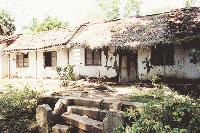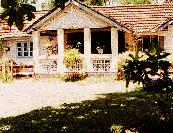




Last week we published the first chapter of Fr. Tissa Balasuriya's controversial book Mary and Human Liberation, for the publication of which he was excommunicated. Today we carry excerpts from the Preface and chapter two of the book. Some readers have objected to the publication of a book which the Bishops have advised Catholics not to read. But we are serialising it in pursuance of the people's fundamental right to the freedom of information and expression:
Manel Abhayaratna Editor of the Catholic Messenger has published a book to counter the claims and views expressed by Fr. Balasuriya. The counter book is titled Mary and Human liberation-the other side. The Sunday Times will publish excerpts from this other side to present a balanced picture of the issue. This will appear in our issue of January 26.
This ancient house by the Bulankulame Wewa is believed to be the oldest house in Sri Lanka dating back almost 400 years. Tharuka Dissanaike reports:
The first monsoon showers had started. The dried, cracked bed of the Bulankulame Wewa-tank- was filling with browned muddy rain water. It took us awhile to locate the old house, which was hidden amongst the thick vegetation on the opposite side of the tank bund. An old farmer cleaning up the culvert that led to his paddy land directed us. The dusty, parched gravel road winding through jak and coconut trees led to our destination- the Bulankulame Walawwa, believed to be the oldest residence still in occupation, well over three centuries old.
The first glimpse of the Walawwa- a single storied square building with a newly tiled portico and small open verandah- was not what one conventionally imagines to be a walawwa. The recent renovations to it's exterior give it the aura of being an upper class rural house- not quite the abode of an aristocratic family for several centuries. As first impressions often go, there was more to the house, than met the eye.


The house at present is in two sections, crudely divided outside by a barbed wire fence. The renovated part of the rambling structure was occupied by the present generation of the Bulankulame family (see right picture). While the other part which truly shows what the old house would have looked like, is abandoned and is in a bad state of disrepair at the moment (see left picture). Two generations ago the entire house was one. Story has it, that centuries ago the whole house spread across several acres in sub units and had seven meda midulas. Only three of these meda midulas remain. Two are in the abandoned section.
At the door-in the renovated section-we were greeted by grandmother Bulankulame who came to live there in the 1950s, years after she married into the family. The interior of the house was dominated by a meda midula. We were informed that the garden was reduced to half it's size to take the new dining room. Around the meda midula the rooms are located- the antique heavy timber doors opening out to a narrow corridor which runs around the garden space. The most interesting thing about the meda midula was the citrus tree laden with dark green oranges- the juice of which we were to enjoy later on that hot afternoon.
At the end of the meda midula was the kitchen with it's ancient soot-blackened chimneys. A face peeps at us through the gap between the thick old wall and the tiled roof. A monkey. Creeping along the gap, his tail hanging down the wall the creature observed us with bright curious eyes. He was shooed away by our hostess, who explained that groups of monkeys are quite a problem there. To the right of the kitchen was an attractive thick plank wooden door with a heavy iron handle leading out to a side garden with a well.
Through the barbed wire fence we entered the other section. This part of the house really looked its age. Carved granite stone steps with a moonstone at the base led up to the house. The front doors were barred. The wooden frame of the roof was rotting and the thick soft- stone walls plastered with a mixture of mud and clay were cracked and crumbling. Walking around the house we came to a crumbling meda midula which gave us access to the rest of the house. Its antiquity clearly showed in the narrow lattice worked frames between wooden columns and the cow dung spread on the floor. Heavy wooden beams held the roof. The gutters were turned out of carved tree trunks. The foundation was of solid granite blocks. And the roof still had some of the ancient petal shaped clay tiles
The Bulankulame family believes that the house predates colonialization. Which would mean that the house is an amazing 300 years - most probably more- old. The main reason for this, beyond family beliefs and stories passed down from generations, is the style of architecture of the house. "The low roof, the flat petal shaped tiles, the single storey structure and other features are similar to those found in the old temple houses of the Kandyan Kingdom," Virangan Kurukulasuriya, Chief Architect of Town Planning Institute said. He said that there wass no way of definitely proving the age of the house scientifically, but added that the general architectural style suggests that it predates existing old residential structures which are being preserved by the Department of Archaeology.
Certain documents from the archives point to references to the house in the 19th century. A report compiled by S.S. K. Wickremanayake, Assistant Director of the Department of National Archives, about the Bulankulame and Nuwarawewa families refers to Robert Knox's "An Historical Relation of Ceylon" where a reference is made of a visit by Knox in 1679 to the Bulankulame Walawwa in Anuradhapura.
Now the Central Cultural Fund is drawing up plans for the conservation of the walawwa, under the Abhayagiriya Restoration project. Already the Bulankulame village, which spreads around the tank and the house, has been declared a conservation zone and certain homesteads in this purana village have been restructured to capture the designs of a bygone era.
Piya Tissa Bulankulame, eldest son of the present occupant, said it was in his fatherÕs time that the renovations to the house were done. To make the house manageable and more comfortable for the inhabitants, the meda midulas were cropped in size and walls were raised and new gutters were added. He says the walawwa had many utility rooms that are now not in use. There were rooms to store rice, salt and dried fish, to keep guns which were used for hunting deer in the thickets and stables with horses and carriages for transport. "The walawwa has been inhabited through 500 years," he claimed. The family trace their roots to the early Anuradhapura era when the sapling of the Holy Bo tree was brought to the country. It is said that the family descends from an Indian prince who accompanied the sapling. Legend has it that the Bulankulames were appointed by the king to look after the Sri Maha Bodhi and the atamasthana and the village of Bulankulame was given to the family by King Devanampiyatissa.
"Because the family was appointed custodians of the atamasthana, we could not move out of Anuradhapura, like other noble families and follow the kings when they were exiled to establish other kingdoms," Piya Tissa Bulankulame explained. The situation of the house embodies the concepts of village planning, the walawwa, the village, the wewa (tank) and temple (Lankarama Dagaba) being in very close proximity.
Although the Cultural Triangle has plans for the conservation of the house, the family is still wary of handing their abode over. But they admit that it is progressively becoming impossible to maintain the house. Ideally the government should lend a hand to the family, with finances and technical expertise to restore the house, while the family continues to occupy the premises. At a time when there is so much attention given to reconstructing the past , living history should never be left to die.
Continue to Plus page 2 - Mary rediscovered: preface from the controversial book * Individualistic, asocial Mariology: excerpts from Chapter 2







Please send your comments and suggestions on this web site to
info@suntimes.is.lk or to
webmaster@infolabs.is.lk